After literally boatloads of fun in Croatia it was time to delve a bit more into the historic and cultural. And while there is plenty of that around the Balkans, there is perhaps no place more relevant for such a quest in the past two decades than Bosnia, and its capital famous for the nearly four year siege from 1992-1995. But long before the war for Bosnian Independence (or War of Serbian Aggression as it is called in Bosnia), there have been centuries and centuries of fascinating history and cultural shifts. I will provide a very brief history summary here just to give a little context to some of the stuff I visited and thoughts I had along the way.
Bosnia was first formed as a country by Ban Tvrtko I in 1377. It unified a number of tribes operating as duchies under the common rule of the Kingdom of Bosnia, encompassing a vast space including most of modern Bosnia and Croatia. The predominant religion was the Bosnian Church, descended from the Bogomils (more about this in Mostar entry), however Orthodox and Catholicism were prominent and most of the royal family were technically Catholics (although what they really practiced is widely debated).
The Kingdom of Bosnia existed until 1462 when Bosnia fell to the Ottoman (Turkish) Empire. Herzegovina fell 19 years later and the Ottomans claimed the remainder of the kingdom over the next 100 years. It was at this point the influence of the Muslim faith began to take hold from the south and the Ottoman Empire ruled until 1878. At this point, the country changed hands to the Austro-Hungarian Empire as part of the Treaty of Berlin and there began to be a large influx of Catholicism from the west, including the building of new churches in Sarajevo. Additionally, there was an influx of Serbian Orthodox refugees. Bosnia was part of this Empire until a very important event occurred in Sarajevo.
The Kingdom of Bosnia existed until 1462 when Bosnia fell to the Ottoman (Turkish) Empire. Herzegovina fell 19 years later and the Ottomans claimed the remainder of the kingdom over the next 100 years. It was at this point the influence of the Muslim faith began to take hold from the south and the Ottoman Empire ruled until 1878. At this point, the country changed hands to the Austro-Hungarian Empire as part of the Treaty of Berlin and there began to be a large influx of Catholicism from the west, including the building of new churches in Sarajevo. Additionally, there was an influx of Serbian Orthodox refugees. Bosnia was part of this Empire until a very important event occurred in Sarajevo.
On June 28, 1914, the heir to the Austro-Hungarian throne, Franz Ferdinand, was assasinated in Sarajevo in front of what is now a Museum and adjacent to the Latin Bridge. This event sparked the beginning of World War I, the end of which saw the defeat and collapse of the Ottoman Empire and Austro-Hungarian Empire and the emergence of Bosnia as part of the Kingdom of Yugoslavia (including Slovenia, Croatia, Bosnia, Montenegro, Serbia, and Macedonia).
Subsequent to World War II, in 1945, the Kingdom became the Socialist Federal Republic of Yugoslavia, a communist state. From there it remained until the collapse of communism in Eastern Europe. On March 3, 1992 Bosnia declared its independence and the Yugoslav People's Army (later under numerous names due to UN pressure) initiated a (preplanned) siege of most major cities in Bosnia at the behest of the Serbian communist leader Slobodan Milošević.
Subsequent to World War II, in 1945, the Kingdom became the Socialist Federal Republic of Yugoslavia, a communist state. From there it remained until the collapse of communism in Eastern Europe. On March 3, 1992 Bosnia declared its independence and the Yugoslav People's Army (later under numerous names due to UN pressure) initiated a (preplanned) siege of most major cities in Bosnia at the behest of the Serbian communist leader Slobodan Milošević.
The siege of Sarajevo lasted nearly four years. There was no power, no supplies, very little water. Artillery fire blasted buildings in the town center from up on the hills. Snipers shot anyone caught in the open indescriminately. Sarajevo is in fact a perfect city to lay siege to because it is surrounded completely by mountains. In Sarajevo over 11,000 people were killed during the four year seige. Other cities fared better and some fared worse. In Prejidor close to 20,000 were killed in the siege and as part of ethnic cleansing. In Mostar, which I'll get to in greater detail in the next post, thousands more were killed and the 427 year old bridge was destroyed. All told there were between 95,000-100,000 deaths. The parks in the cities were converted to cemeteries with white marble gravestones marking those who had died in the war.
After the official peace agreement was signed on December 14, 1995 Bosnia & Herzegovina emerged and began rebuilding. Today it is well on its way to repairing the damage, however, it is impossible to replace some of the priceless artifacts (such as the books lost in the destruction of the National Library) and even more so the lives that were lost. That said, I went to high school and was friends with several Bosnians who had fled during the war and I have looked forward to visiting the country ever since. I wasn't sure what to expect but what I found was an amazing country: everything from the people to the sights to the food to the culture, it really blew me away. But before I dive into my experience in Sarajevo, let me first include a brief blurb about my experience riding in from Croatia on a 4pm bus that should have gotten me in around 10:30 but actually got me in around 11:45.
"We stop at a little checkpoint area where the bus pulls to the side. The assistant driver exits and walks to the Croatian side to summon a Croatian police officer. The man comes back and the officer takes a cursory glance at everyone's passport or ID card and then exits. The driver does the same with the Bosnian booth. This time, the man collects all of our passports and exits the bus. We sit for about 10 minutes and then the assistant driver returns with the stack of passports and ID cards. We drive trough the border and into Bosnia before he has finished returning them, causing a momentary flash of panic that perhaps mine isn't in the stack. It is, but upon reviewing it, I am surprised to discover there is no stamp. No stamp into Croatia, no stamp into Bosnia. Very loose ship these Balkan countries are running.
Back on the bus, they have switched off the lights and we are watching a Croatian TV show. The production value is the same as you might find in a home video of a high school play. It consists of a fat blond man in a leopard print jacket and a lecherous poor-man's Stanley Tucci in a grocier's apron running around a stage while a bald James Earl Jones look a like with thick coke-bottle glasses yells at them from behind a desk. The two Croatian teenage girls in front of me are cracking up. As we ride east, the towering cliffs and crystal blue waters of the Croatian coast have given way to what appears as desolate riverbeds. A lightening storm is on the horizon- bolts snake across the dark sky casting the distant mountains in an eerie almost spectral light. We stop to pick up another passenger. The air gets cooler, the sky darker. The bus rolls on into the night.
When I arrive in Sarajevo I look nearly as tattered as portions of the city itself. My sandals are destroyed and my shorts are stained, reek, and have torn apart from the back left pocket. I haven't showered in 3 days and my hair is matted to my head in a ball of grease under my hat. My feet are covered in dirt and grunge and I'm coated in a layer of sea water under a layer of sweat. I share a cab to the city center with two girls from the bus. Along the way we stop to get cash. We're all weary of leaving our stuff in the cab unattended with the driver so we take turns getting cash and keeping an eye on him. Everything is fine. We get to the hostel at the tourist price (i.e. higher price). The hostel is at the top of four flights of stairs, but once inside I really like it. There is A/C, a TV, a Playstation, and two really nice common rooms. I'm not sure yet what to make of Sarajevo."
The next day I decided to start my walk of the city on the south side by the river. Since the war there has been extensive rebuilding and rehabilitation in this area. You will walk along one stretch and it will look just as lovely as any old European city.
Then you will walk just a bit further and you will see a building that still has bullet and artillery holes, some patched, some not.
And if you get off the main drag you'll come across buildings that took a serious pounding and have yet to be reinhabited let alone refurbished.
But more than not, you'll find outstanding architecture and a commitment to revitalize and rebuild the city. I love this building and the cool loop bridge:
One of the main things I really wanted to see in Sarajevo apart from bearing witness to some of the devastation of the war was the remnants of the Olympic venues from the 1984 Winter Olympic Games. I tracked down the indoor Olympic center which appears to still be in use.
From there I started walking north past Ali Pasha's Mosque and toward the Olympic Stadium. Much like the city I wasn't sure what to expect. When I got there, I suppose it was about what I thought I would find. More derelict than useful now, I believe it is only used as a part-time facility for a gym that is attached to what was once the main entrance. Here is a shot of the inside that I got through the bars of the long-since chained gates around the stadium:
And here is one of me with the torch. My third Olympic Stadium of the trip.
After that I headed back to the main part of town where I came across the brand new mall center. Dino suggested I check this place out so went in to see if I could find a place with cheap sandals (since mine self-destructed on the way to Sarajevo). I didn't find anything cheap there, however, I did find a little sweets shop selling sampita which Dino had also highly recommended. Sampita is basically a little bit of chocolate cake on the bottom, little bit of flaky pastry on top, and then about four inches of sweet creamy meringue between the two. It was a sugar overload, especially for me, but I'd be lying if I said I didn't like it.
Finally it was time for me to head toward old town. As you approach the old town from the west you will invariably come by one of the main city squares. One one side is the old Army Hall- peppered will bullet and artiliery holes. Nearby is the newly rebuilt Synod Orthodox church (the largest Orthodox church in the city). Just 1 block away is the Cathedral of the Holy Heart of Jesus (the largest Catholic church in the city). And a mere two blocks from there is Ghazi Husrev Bey's Mosque (the largest Muslim mosque in the city). This is a perfect example of the mixture of religions and cultures in Bosnia. And to stay even, here are all three:
When I thought of someone who is a Bosnian, I always thought of a person who was born in or whose family came from Bosnia. And as many Bosnians have told me, prior to the war, many people felt that way. There were Orthodox, Catholics, Muslims, and Jews all living in the same community- religion was something people did but it didn't define them. Then, according to the people I met, during the conflicts, Orthodox became somewhat of a synonym for Serbian, Catholic became a synonym for Croatian, and Muslim a synonym for Bosnian.
So when it all began, again according to the people I met, people who had been living their whole lives in Bosnia, because they were Orthodox thereby Serbian descent, climbed the hills and began shelling their friends and neighbors. Similar for the Croats. It's really a hard concept for me to understand. I imagine it's a hard concept for some even born in the area to understand- even the tour guide I had later in the day said he still struggles to grasp exactly how that could have happened.
Similar to the blend of religions and cultures, the city itself is a blend of architectural styles. But it is done in such a unique way. I have never really experienced anything like it. I wrote this at the time:
"The city is a dizzying blend of the ancient and the new, history preserved and history rather forgotten, a city destroyed by siege and rebuilt into the 21st century. It's a city steeped in the past but with an eye to the future.
The air smells of exotic spices and cool hookah smoke drifts through the hot dusty streets. As you walk east through the city center you walk from eastern Europe to western Asia. It immediately conjures up images of Istanbul, Egypt, and even India."
If you start at what was once the National Library (being rebuilt) and you walk west through the old town, you first pass through the Turkish section. It feels as if you were transported to old Istanbul.
Less than five minutes later you have traversed into Austro-Hungarian Europe. It is here you will find the Catholic and Orthodox churches emerging and that classic Austro-Hungarian architectural style.
A bit past that you find yourself back in communist era Yugoslavia- the boxy buildings, exposed concrete, stark designs. Then if you keep walking another 5-10 minutes you'll find yourself in the newest part of Sarajevo- the modern section. Large corporate buildings- modern designs sheathed in glass. Malls, shopping centers, parking garages. The whole modern mess.
You've traversed 4 civilizations and 500 years in less than a half an hour. If you're like me, time traveling will build up quite the appetite, and when in Bosnia, the best solution for a voracious appetite is cevapi. Cevapi are beef (almost meatball-like) sausages grilled and served with warm flatbread, chopped onion, and a type of "cream cheese" that reminded me most of a cheese spread of sorts. It was absolutely fantastic.
The traditional way to order it is with a glass of yogurt to drink. Yes, yogurt. It's a thin sour slightly salty yogurt. I gave it my best effort but could only make it halfway through my gup. I'm not a huge yogurt guy and I just couldn't get there on drinking it. To make up for it, I did stop at an ice cream place Dino recommended which had outstanding homemade hazelnut ice cream. After I had done the tour, it was time to do the tour. In an odd twist, the free tour didn't go off until 4:30. By this point I had seen the vast majority of the city, but our guide was able to elaborate on the details behind some of the history- most of which made its way into the intro above.
Some other interesting things he noted, because the water lines were cut, the only source of water in the city came from the Sarajevo Brewery which sits on a natural spring. Many Bosnians died for a few jugs of water. He also took us to a really interesting place which used to be a stop-over for caravans. There was a stable for camels, rooms to rent for the night, storerooms to keep the wares safe, and a restaurant for hungry travelers. Today it's mostly a coffee shop, restaurant (still there), and souvenir shop. Really cool though.
Finally, we went back to the main mosque where we talked about the procedure Muslims go through to wash before prayer. It's especially relevant here as there is an outstanding outdoor fountain used for washing. In this shot you can see the old clocktower- which after an earthquake, the clock and mechanism was purchased and installed from the company that made the one for Big Ben in London. To the left is the mosque entrance and below the tower and behind the fountain is the indoor wash-fountain which is used during the cold winter months.
The remainder of the night was more or less spent chilling at the hostel since I had an early 7:05 train down to Mostar. The train itself cost only 5 euro, however, if I had the option to do it again I think I would have sprung for the "business train" given my experiences on the local train. That said, I was in it for the experience so the delay didn't really matter. It was more a problem for my host who was picking me up, supposedly at 9:30. I documented the ride as I went and since there are reflections on my time in Sarajevo included, I've decided to post the train ride here rather than as part of the Mostar post.
"Leaving Sarajevo proves easy enough but with the of advised lack of punctuality. Our 7:05 train departs at 7:23 after a series of announcements in Bosnian which I cannot follow. Thankfully it appears to be the right train and I am happy to be on my way. The train itself appears to have been outfitted sometime in the 60s or early 70s. The seats are a dingy brown- long faded from their original crimson. The floors are dotted with stains, the windows browned with decades of use and misuse. Most of the decor is made of wood.
And despite the numerous no smoking signs plastered along the train, like seemingly everything else in Bosnia the train is permeated with the odor of cigarette smoke. And as we get underway it's immediately apparent why- people just ignore the signs and smoke anyway. It is at this point I realize that I'm going to be mildly sick for the rest of my time in the Balkans. There is just no way around it- 5 minutes in and my nose is completely stuffed and I'm sneezing. Clearly it doesn't help that the communist-era train has the windows welded shut. But such is the life of the traveler. Take vitamin c, drink water, bring tissues. Adapt.
And despite the numerous no smoking signs plastered along the train, like seemingly everything else in Bosnia the train is permeated with the odor of cigarette smoke. And as we get underway it's immediately apparent why- people just ignore the signs and smoke anyway. It is at this point I realize that I'm going to be mildly sick for the rest of my time in the Balkans. There is just no way around it- 5 minutes in and my nose is completely stuffed and I'm sneezing. Clearly it doesn't help that the communist-era train has the windows welded shut. But such is the life of the traveler. Take vitamin c, drink water, bring tissues. Adapt.
As the train moves west through the city you could really see the extent of some of the damages of the siege to outlying buildings. Whole blocks have been laid to waste- shelled or burned, their roofs have long caved in and the walls crumble. But there is a strong spirit and resolve in the Bosnian people, especially the youth. They are rebuilding, refurbishing, and constructing new modern buildings and infrastructure.
Is it so hard to believe that another Olympics could be hosted here? Looking at the derelict stadium only yesterday I may have said yes. But the more of the city I came to see, the more I began to realize the truth: this is a city, a country, and a people that have been knocked down time and time again. Conquered and abandoned, attacked and defended, destroyed and rebuilt. They are a culture of getting back onto their feet. Is another Olympics in the near future likely? Probably not. But is it conceivable down the line? Absolutely.
Is it so hard to believe that another Olympics could be hosted here? Looking at the derelict stadium only yesterday I may have said yes. But the more of the city I came to see, the more I began to realize the truth: this is a city, a country, and a people that have been knocked down time and time again. Conquered and abandoned, attacked and defended, destroyed and rebuilt. They are a culture of getting back onto their feet. Is another Olympics in the near future likely? Probably not. But is it conceivable down the line? Absolutely.
It just remains to be seen how long it takes for the city and country to shake off the lingering effects of communism and the war. Among the youth there is energy and promise, but among some of the older people, the graft, corruption, and xenophobia remains. Just yesterday some English fellows and I, after legitimately purchasing tickets for the tram, were accosted by three men from the tram control board who tried to extort us for 15€ each by collecting our IDs and refusing to return them.
It happened like this: we got on the tram and asked the conductor what to do. He said to buy a ticket, 1.80 mark, and then I asked if that was it and he replied yes. What we didn't see was that hidden behind his booth was a little green validation machine with instructions in Bosnian that you have to validate your ticket. The three tram control men were standing right there watching us buy our tickets and said nothing to help us.
They then waited 2 stops and came up telling us "you need to stamp, no problem, do you have identification?" Once we had handed them over they suddenly said we'd have to pay 28 mark (about 14€) each in a fine because we didn't stamp and refused to return our ID's. At the next stop they pulled us off the train and threatened to call the police which they claimed would be a 50€ fine. Notably they never actually called. One of the three would open his phone and pretend to dial something and then close it.
They then waited 2 stops and came up telling us "you need to stamp, no problem, do you have identification?" Once we had handed them over they suddenly said we'd have to pay 28 mark (about 14€) each in a fine because we didn't stamp and refused to return our ID's. At the next stop they pulled us off the train and threatened to call the police which they claimed would be a 50€ fine. Notably they never actually called. One of the three would open his phone and pretend to dial something and then close it.
It was immediately clear to me that this was a tourist shakedown by corrupt train officials. Probably these guys do this to groups of tourists a few times a week, extorting a hefty sum of euro and then treating themselves out at the pubs. Knowing that their accusations were ridiculous since they saw us buy them and refused to help us, and were clearly extorting us for an honest mistake, I told the other guys to hold firm. I'd take my chances with the police. Meanwhile we stopped a nice Bosnian man and asked for his help- we needed a phone to call the hostel and get their advice.
As we were calling he started talking to the ringleader of this sham and suddenly the guy throws out an offer of only three of us having to pay the fines. I knew we had him on the ropes. The hostel didn't provide much help I think because it was the lazy dude working the desk. Finally, a lady came by and once we told her our story she started laying into the guy with extreme prejudice and he immediately handed back our IDs. The three then instantly disappeared almost as if vanishing into mist. Clearly what he was doing was illegal. The man who first tried to help said, "I am embarrassed. That is the old way of thinking here, they have no education, no reason, no right. But there is nothing we can do, but I am sorry."
Until the country shakes off this old communist rooted way of thinking and corruption, it will always be held back. Stories like this deter businesses and tourists from coming to Bosnia. And it's a tragedy because by and far the Bosnian people are lovely.
As we were calling he started talking to the ringleader of this sham and suddenly the guy throws out an offer of only three of us having to pay the fines. I knew we had him on the ropes. The hostel didn't provide much help I think because it was the lazy dude working the desk. Finally, a lady came by and once we told her our story she started laying into the guy with extreme prejudice and he immediately handed back our IDs. The three then instantly disappeared almost as if vanishing into mist. Clearly what he was doing was illegal. The man who first tried to help said, "I am embarrassed. That is the old way of thinking here, they have no education, no reason, no right. But there is nothing we can do, but I am sorry."
Until the country shakes off this old communist rooted way of thinking and corruption, it will always be held back. Stories like this deter businesses and tourists from coming to Bosnia. And it's a tragedy because by and far the Bosnian people are lovely.
We continue our train ride through the Bosnian mountains. A thick fog has set in- obscuring all but the nearest pines. We chug along through forests, across massive bridges soaring over expansive valleys, and through long tunnels where we are pitched into darkness. For there are no lights on this train. We sit in pitch black for several minutes- the only thing visible is the 8-10 tiny orange orbs glowing from the tips of the lit cigarettes. When the fog briefly breaks, the mountain passes are indescribably beautiful. We press on through the fog, into the future, leaving a smoky trail of the past in our wake.
We are stopped about 1/2 of the way from Mostar around a town called Celebic. No announcement as to what the problem is. The clock outside the station reads high noon even though it is 9:10. I have to leave my cabin because so many people are smoking and the windows refuse to open, even against the most liberal application of force. I am suffocating. At last a woman comes out of the station and blows a whistle twice. We are on our way again.
We stop again. The conductor sounds the horn loudly. Something is blocking the tracks. A few minutes pass, another horn. Then a third and final long blast. Then nothing. We are moving again.
Another stop, this time in Jablanica. We've been here at least 20 minutes. No sign of why the delay. I estimate we are at least an hour behind schedule. Rambunctious children run screaming up and down the aisles, unchecked by their mothers. The men next to me are on cigarettes number 7. A train approaches. Perhaps the 8:00 "business train" is now passing us. Yes, that's exactly what is happening.
I should have taken that. Frustration is beginning to grow- not because of the smoke or the loud children or the train that passes and actually looks comfortable. But because of this delay I am now very late in meeting my host Bata who has held a spot for me on his tour. And still we wait. I see the other boys from the hostel on the train that is passing us. Lesson to be learned: Bosnian trains are reliably unreliable. Never take Bosnian local trains. I ask a Bosnian man what is wrong and if the train is broken. He replies, "ehh... it is Balkans train." This is my new life motto any time I'm running late. "Ehh... I'm on Balkans time."
I should have taken that. Frustration is beginning to grow- not because of the smoke or the loud children or the train that passes and actually looks comfortable. But because of this delay I am now very late in meeting my host Bata who has held a spot for me on his tour. And still we wait. I see the other boys from the hostel on the train that is passing us. Lesson to be learned: Bosnian trains are reliably unreliable. Never take Bosnian local trains. I ask a Bosnian man what is wrong and if the train is broken. He replies, "ehh... it is Balkans train." This is my new life motto any time I'm running late. "Ehh... I'm on Balkans time."
Apparently we are only 30 minutes away from Mostar but we have been here for almost an hour. I can't understand why we didn't follow the "business train" out of here after the other one went by going the opposite direction. It's 10:23 now and we are officially an hour late plus the 30 or so minutes we have left to go. It's entirely possible we arrive at 11:30, over 2 hours late for a 2:15 minute train. This is the kind of logistics nightmare I have been hearing about in the Balkans and what I think, in large part, keeps the tourists away. Much more so than safety concerns.
In any event the name of the game is patience. No point in getting upset, it won't get us out of here any faster. And if Bata's tour goes off without me, so be it. I did everything I could to get there when he wanted me and the girl at the hostel claimed the trains were reliable (I was originally going to take the 6:50 bus which would have had me there 20 mins ago). The only real bothersome thing is the cloud of smoke enveloping us and the need to use the bathroom and/or eat. With nothing to do, I began writing. At 10:40 we started again. My new Bosnian friend seemed confident we'd make it through clean now. I wasn't convinced. The scenery from here out should be beautiful.
It was. I apologize for the picture. The windows of the train hadn't been washed since 1970 and the hot-boxing of the train created a perpetual smoke haze. From what I could see, it was beautiful. We eventually arrived at 11:23, exactly 2 hours late. Bata's tour was able to pick me up, although I missed the intro. The guys next to me smoked 14 cigarettes. Each."
In any event the name of the game is patience. No point in getting upset, it won't get us out of here any faster. And if Bata's tour goes off without me, so be it. I did everything I could to get there when he wanted me and the girl at the hostel claimed the trains were reliable (I was originally going to take the 6:50 bus which would have had me there 20 mins ago). The only real bothersome thing is the cloud of smoke enveloping us and the need to use the bathroom and/or eat. With nothing to do, I began writing. At 10:40 we started again. My new Bosnian friend seemed confident we'd make it through clean now. I wasn't convinced. The scenery from here out should be beautiful.
It was. I apologize for the picture. The windows of the train hadn't been washed since 1970 and the hot-boxing of the train created a perpetual smoke haze. From what I could see, it was beautiful. We eventually arrived at 11:23, exactly 2 hours late. Bata's tour was able to pick me up, although I missed the intro. The guys next to me smoked 14 cigarettes. Each."

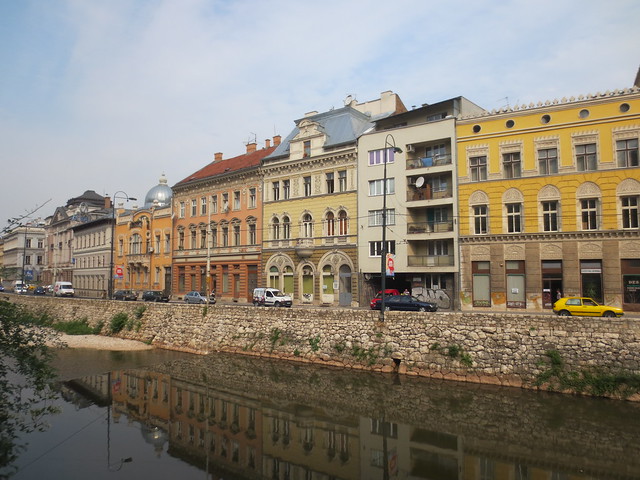
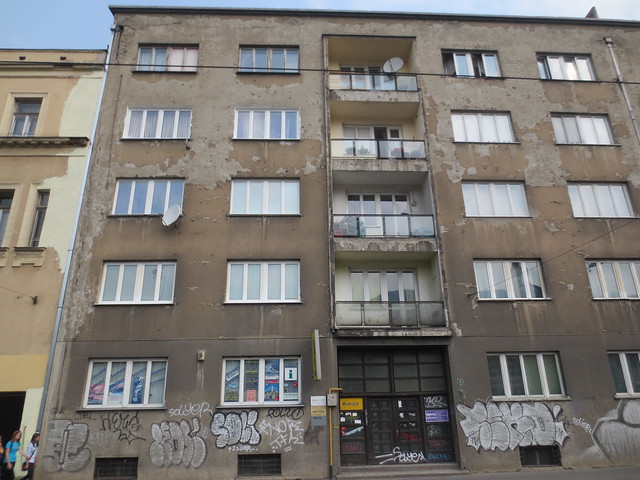

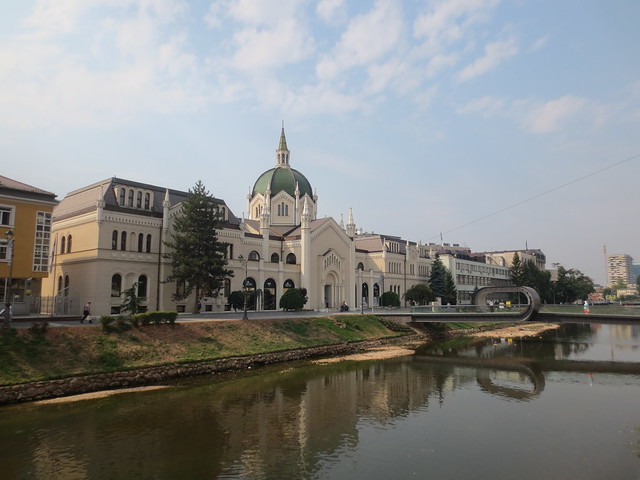
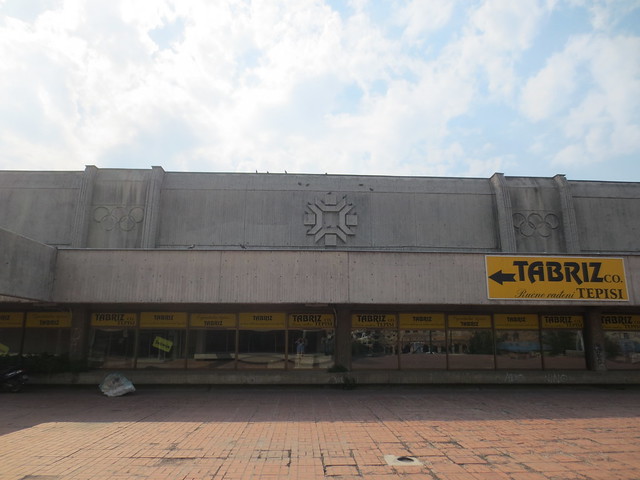
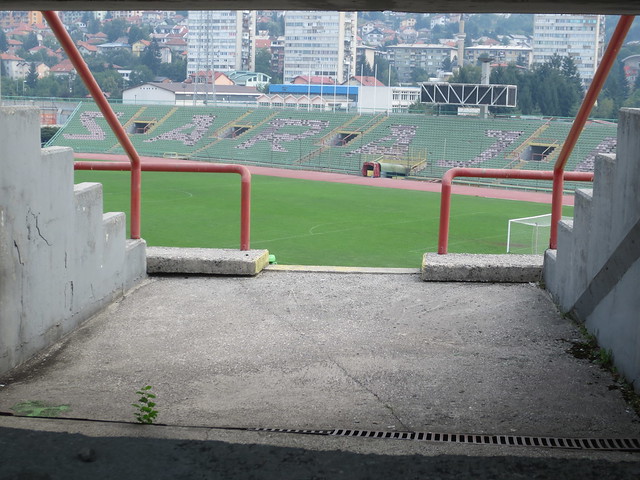
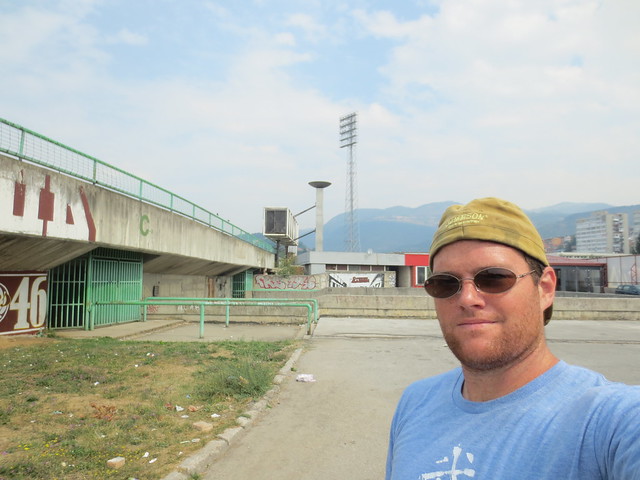
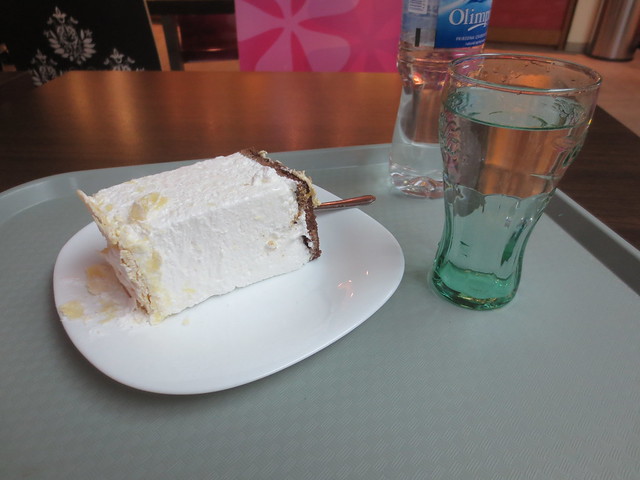



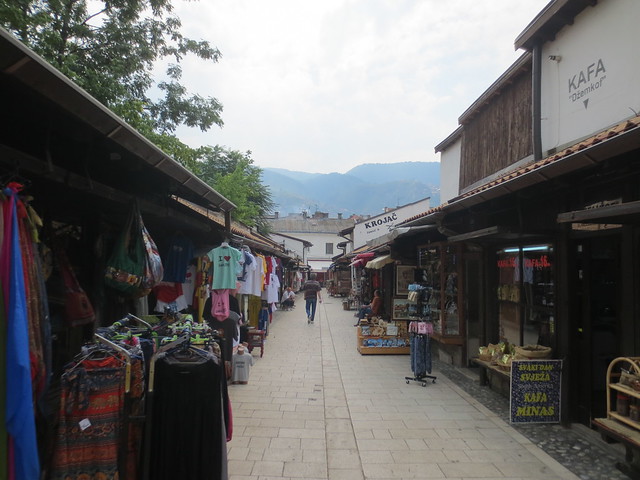

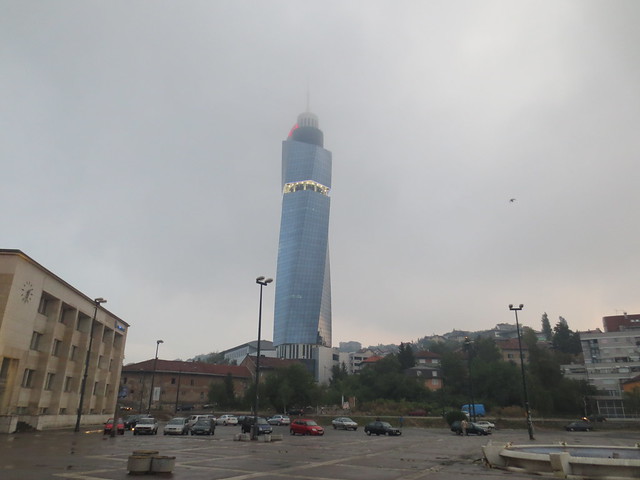

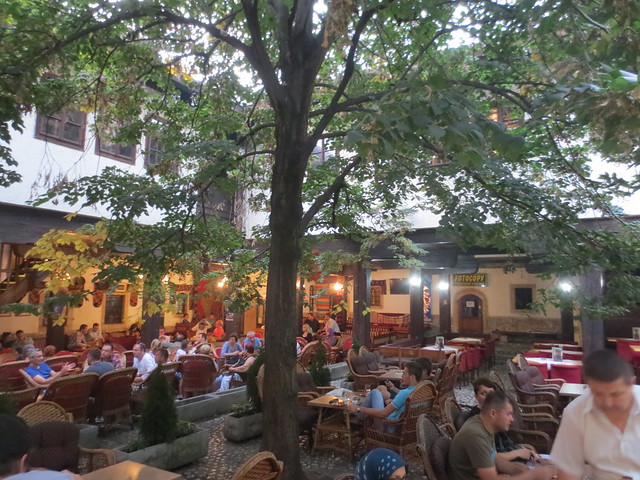
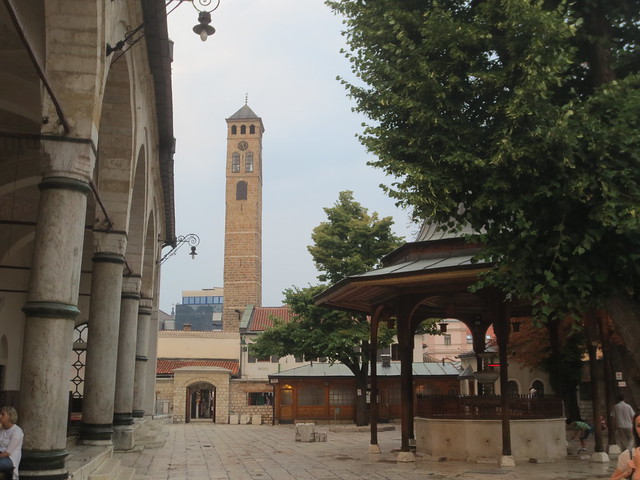
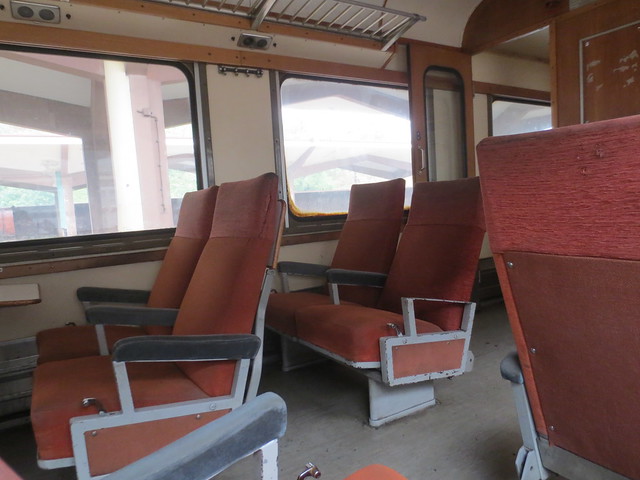
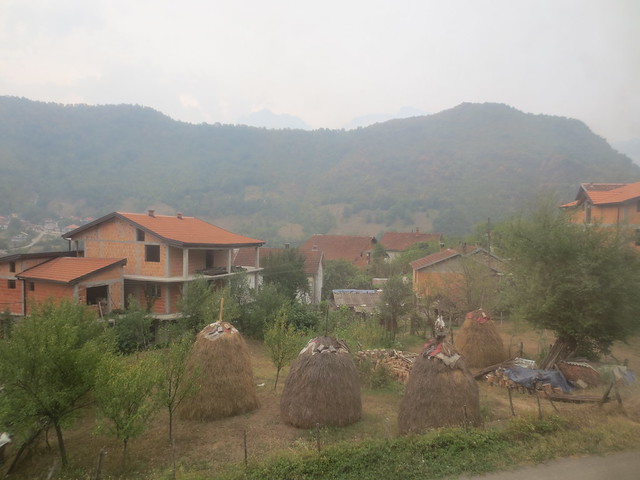
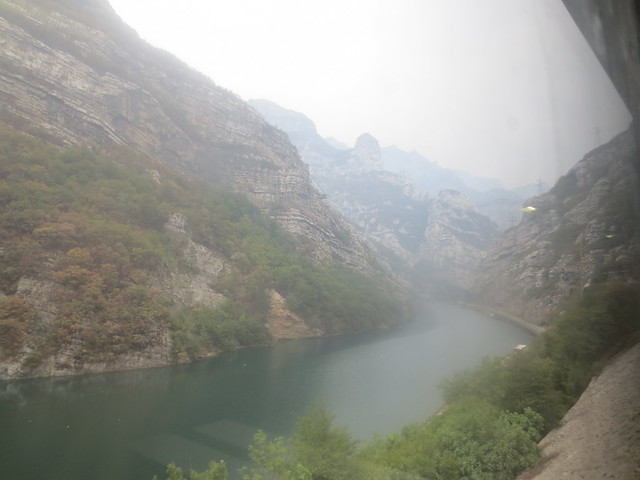
No comments:
Post a Comment